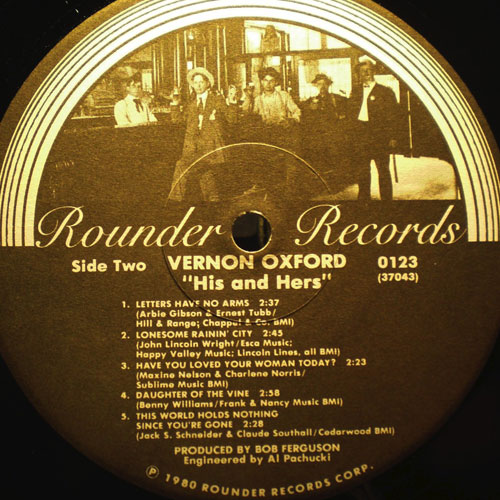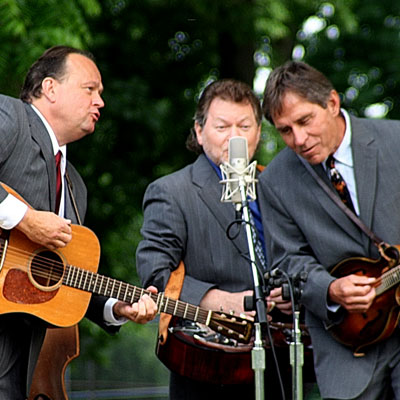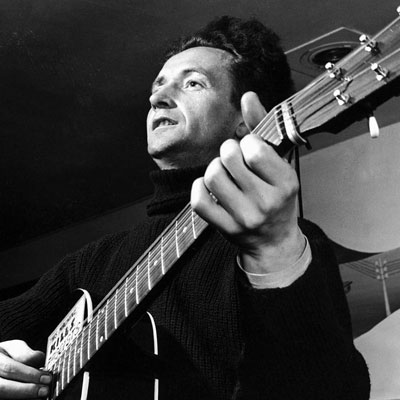Rounder: 40 Great Years Of Music
The Rounder Records Story: The 1980s By Geoffrey Himes
“After George Thorogood’s success, every blues artist in the world thought we had the magic touch and approached us about doing an album,” recalls Rounder producer Scott Billington. Thorogood’s second Rounder album, 1979’s Move It on Over, had cracked the top 40 on Billboard’s pop charts and earned a gold record, as did his fourth album, Bad to the Bone, which Rounder had recorded before working out a deal to turn the tapes over to EMI. Suddenly musicians were approaching the tiny Massachusetts company as much for its industry clout as for its artistic integrity. It was a mind-twisting turn of events.
The integrity still mattered, however, and Rounder picked its blues projects carefully. Clarence “Gatemouth” Brown was a logical choice, for he was as eclectic as the label itself. He was born in West Louisiana and raised in East Texas, playing the Cajun and country tunes beloved by his father. It was only when he moved to Houston as a young man that he jumped-literally-into the blues. One night in 1947 at the Bronze Peacock, headliner T-Bone Walker fell ill with an ulcer and was helped off the stage. Brown leapt from his seat and started playing every boogie riff he knew, and by the end of the night, the whooping audience was stuffing money into his shirt and pants. He was quickly signed to Duke-Peacock Records and enjoyed several Gulf Coast hits. But he was too restless to be pigeonholed for long. Soon he was playing jazz and R&B in addition to blues, Cajun and country; he even pulled out his fiddle at least once in every show. By the 1970s, he was based in Nashville, backing soul singers on the TV show The!!!Beat, and eventually joining country star Roy Clark on Hee Haw. “I don’t like to be listening to the same old stuff all the time,” he explained. “I can’t stand up on a bandstand and play the same style of music every night…. I see all these other guitarists, and they’re stuck in the same mud hole getting nowhere.”
As producer, Scott Billington wrested Brown out of his current comfort zone and thrust him back in front of a big horn band. Enlisting some of the top horn men in New Orleans, including 1950s R&B studio legend and modern jazz saxophonist Alvin “Red” Tyler, Billington and co-producer Jim Bateman pushed Brown to tackle some classic Texas blues numbers, including Albert Collins’ “Frosty.” The galvanizing results revitalized Brown’s career and even won the album, Alright Again!, the 1982 Grammy Award for Best Traditional Blues Recording. That gold statuette, Rounder’s first, bolstered the label’s reputation almost as much as Thorogood’s sales numbers. “It’s the biggest prize the record industry has,” Billington points out, “and it gives you a legitimacy in some people’s eyes. They look at you and say, ‘OK, these guys can do the job; they won a Grammy.’” Soon there were even more musicians knocking on Rounder’s door.
One of them was Johnny Copeland, another Texas bluesman who had lapsed into semi-obscurity after a promising start. As Billington had with Brown, producer Dan Doyle resuscitated Copeland’s by putting him in front of a jazzy horn band. Instead of using New Orleans veterans, however, Doyle hired some of the top avant-garde jazzers in New York, including saxophonists Arthur Blythe, George Adams, and Bayard Lancaster. As you can hear on “Everybody Wants a Piece of Me” from that 1981 release, the horn players aren’t content to merely repeat the same riff but toy with the voicings behind Copeland’s stinging solos to make things more interesting. It worked; Copeland’s career revived, and that made possible the eventual emergence of his Harlem daughter Shemekia as a major blues singer.
Brown’s album provided Rounder with an entrée into the New Orleans music community just as that scene was starting to recapture national attention. The New Orleans Jazz & Heritage Festival, begun in 1970 as a showcase for local talent, was becoming the favorite annual destination for roots-music lovers the world over. Inside the festival’s white tents and on the grass before the outdoor stages, out-of-towners were discovering pianists with a carnival syncopation, horn players that straddled jazz and blues, brass bands that built dizzying chords without guitar or piano, survivors of the city’s golden age of R&B, and Mardi Gras Indians swallowed up in giant costumes of plumes and beads. Rounder documented it all.
The label snapped up a 1972 tape (produced by festival founder Quint Davis) of the city’s most famous pianist, Professor Longhair (aka Henry Roeland Byrd). House Party New Orleans Style, which won a Grammy for Best Traditional Blues Album, was highlighted by “Tipitina,” a song so famous that the city’s best nightclub was named after it. Billington took Fess’s most gifted, most troubled heir, James Booker, into the studio for a new session. “He was probably the only person I’ve ever worked with that I thought was fairly a genius,” the producer declares. “His technique was as good as Artur Rubinstein or any classical pianist; sometimes even piano players are surprised to learn it’s only one piano player on his records. But he was also one of the most tragically flawed musicians New Orleans has ever produced. Three weeks before we were to go into the studio, he had some kind of breakdown and ended up in Baptist Hospital. Booker went into this state of withdrawal and didn’t want to play any of the songs we’d picked out; he didn’t even want to talk to anyone. I was worried that I’d have to go back to Boston and explain why I’d spent $8,000 without coming up with any usable tracks. On the third day of our otherwise fruitless sessions, I went back into the studio to see if I had any salvageable music and Booker was there in the door, ready to go, and we cut all that stuff that’s on the Classified album. I was so relieved I had something that I gave him a check. In the middle of playing ‘Tipitina’ he asked, ‘When does the bank close?’ Someone said, ‘Three o’clock’; he slammed the piano shut, was out the door and no one saw him for weeks.”
Jazzfest was also a showcase for music from rural South Louisiana, both the Cajun of the French-American community and the zydeco of the African-American community. Beausoleil, a Cajun band led by Michael Doucet, demonstrated how closely related the two genres were on Michael’s composition, “Zydeco Gris-Gris.” Michael, after all, had studied not only with Cajun fiddlers like Dennis McGee but also with Creole fiddlers like Canray Fontenot. Buckwheat Zydeco (aka Stanley Dural) had led an R&B band until he was drafted to be a keyboardist in the band led by Clifton Chenier, the universally acknowledged King of Zydeco. Buckwheat learned to play zydeco’s lead instrument, the accordion, but he never forgot his R&B roots, as one can hear on his adaptation of “Ya Ya,” originally a hit for New Orleans’ Lee Dorsey.
The accordion was also the lead instrument in Tex-Mex conjunto music, and Rounder jumped into that community too. Santiago Jimenez had been the godfather of the genre, but his son Flaco modernized that sound through his collaborations with Doug Sahm, Ry Cooder, Dr. John, and Los Lobos. But Flaco never lost touch with his roots in the barrios of West San Antonio, as he proves on his father’s composition, “Viva Seguin.” Flaco, his brother Santiago Jr., and Steve Jordan (the “Conjunto Jimi Hendrix”) popularized the Tex-Mex sound and mesmerized a punk-rocker from Denton, Texas, named Carl Finch. Finch picked up the accordion, started playing conjunto polkas and soon branched out to play Polish and Czech polkas, cha chas, and mazurkas as well. His band Brave Combo soon learned that audiences were starving for joyful dance music like the polka standard “Happy Wanderer” and continue to enjoy a long career feeding that hunger.
Rounder hadn’t abandoned the artists from its first decade. Rory Block, a member of Woodstock Mountains, recorded the original blues “Got To Have You Be My Man” for one of her 13 solo albums on Rounder. Tony Rice, who had sung two Gordon Lightfoot songs on 1975’s J. D. Crowe & The New South, chose another as the title track of his 1984 solo album, Cold on the Shoulder. “It was a great repertoire that no one else was doing,” Irwin comments, “in the same way that no one was doing Dylan songs till Joan Baez and Judy Collins did those songs totally differently and made them work. That’s what Tony did with those Lightfoot songs, which were almost bluegrass anyway.” Earlier, in 1980, Rice had gone into the studio to make another solo record with Crowe, Phillips, Doyle Lawson, and Bobby Hicks but soon realized it was morphing into a collective-band project with everyone making equal contributions. “My Blue Ridge Cabin Home,” attributed to Earl Scruggs’ wife Louise Certain, is from the resulting record, The Bluegrass Album. It was supposed to be a one-off project, but the Bluegrass Album approach proved so popular that six albums have appeared so far under that name.
Rice had been replaced in Crowe’s band by Keith Whitley, Ricky Skaggs’ childhood friend from East Kentucky. Whitley had left Ralph Stanley’s band because he wanted to sing more mainstream country, which Crowe had already integrated into his newgrass repertoire. Crowe turned over his 1982 recording session to his young protégé, hiring a Nashville rhythm section to provide a honky-tonk thump to songs like Lefty Frizzell’s “I Never Go Around Mirrors.” The arrangement provided the blueprint for all of Whitley’s later country hits; he would even recut “I Never Go Around Mirrors” for RCA. Keith was having some problems and missing dates so J.D., who was originally going to have the album come out under Keith’s name, changed his mind and had it released as a JD Crowe and the New South album.
When Keith was ready to pursue a country career, Ken Irwin says, “It made sense for him to sign with RCA; we weren’t prepared to deal with that world. Just like with George Thorogood, we couldn’t see ourselves holding Keith back; we wanted to help him have the career he deserved. We made an agreement with RCA where we got a percentage, so it worked out for everybody.” Years later, J.D. and engineer Steve Chandler went back into the studio, overdubbed some parts, and remixed the album adding a few songs which Keith had cut for Rounder as demos to pitch to major labels but which had never been released.
In 1984 Hazel Dickens recorded the greatest of her many great songs: “Mama’s Hand.” With remarkable detail, she conjured up the day in 1954 when she boarded the Greyhound bus that would take her from West Virginia to Baltimore: “I said goodbye to that plain little mining town/With just a few old clothes that had made the rounds/ [But] It was hard to let go of mama’s hand.” “I remember her being sad,” Dickens recalled, “and she said, `Surely you’re not going before supper,’ and I said, `I have to catch my bus.’ She would have liked me to stay, but she knew there was nothing there for me. She’d seen all her other children go off to work or get married, so she knew she had to let go.” When Lynn Morris re-recorded the song for Rounder in 1995, it topped the bluegrass charts and was voted the IBMA’s Song of the Year.
Irwin had asked Tony Trischka to back up Dickens on the soundtrack for the Barbara Kopple movie, Harlan County USA, but the banjoist said, “Ooh, I’m going to be out of a town, but I have a 16-year-old student named Béla.” “That’s three strikes right there-16, student and ‘Béla,’” Irwin remembers thinking. “But he was really good.” Fleck eventually recorded seven solo albums as well as band projects with Spectrum and New Grass Revival for Rounder before going on to fame and fortune at Warner Bros. and Columbia. His banjo instrumental “Whitewater,” featuring Rice, Bush, Douglas, Stuart Duncan, and Mark Schatz, is from the solo album Drive. Fleck eventually returned to Rounder in 2009 to release a Flecktones Christmas album and the soundtrack to his African-music documentary, Throw Down Your Heart. “We learned early on that losing someone to another label is not the end of the world,” Rounder founder Marian Leighton Levy says. “It’s not necessarily the last time you will work with them. We became fairly philosophical about it, unlike some people who go, ‘I’ll never work with that person again.’ You don’t want to burn bridges. If someone comes along and offers a lot more money than we as an underfunded label can, you wish them well and hope they’ll come back someday.”
Rounder was well aware that its fan base was as interested in folk singer-songwriters as in bluegrass and Cajun bands, but the label left that corner of the roots-music world in the hands of labels such as Philo and Flying Fish (founded by ex-Rounder producer Bruce Kaplan), both distributed by Rounder. But when those two labels went out of business, Rounder felt an obligation to take them over to protect their catalogues. And once they had these labels on their hands, it made sense to sign new singer-songwriters. One of the most notable was Nanci Griffith, whose “Once in a Very Blue Moon,” co-written by Pat Alger of Woodstock Mountains, provided the template for her long career at MCA, though she did return to Rounder in 2006. One of her early admirers, Lyle Lovett, sings harmony on the track. Another key signing was John McCutcheon, who turned to the original folk singer-songwriter, Woody Guthrie, for the children’s number “Howjadoo.” Rounder eventually reissued Guthrie’s Library of Congress recordings on CD, and developed an ongoing relationship with Woody Guthrie Publications, shepherded by Woody’s daughter Nora.
As the world’s premier string-band label, it was logical-if only in retrospect-for Rounder to move into Klezmer, the Jewish Diaspora folk music that often featured fiddle, banjo, string bass, and accordion. The song “A Freylekhe Nakht in Fan Eydn” came from the counter-programming holiday album, Oy Chanukah! and featured jazz clarinetist Don Byron. It seemed just as logical to embrace the cowboy-music revival. Doug Green was a musicologist who had written liner notes for Rounder and essays for the Country Music Hall of Fame, when he decided to put his love for Hollywood cowboy music into action. He formed a group called Riders in the Sky, which always maintained the difficult balance between poking fun and genuine affection, as one can hear on their original tune, “Cowboy Jubilee.”
Inasmuch as New Orleans is as much a Caribbean city as an American one, it also made sense for Rounder to move into reggae as well. “The reggae didn’t seem out of place from everything else we were doing,” Nowlin insists. “It was very traditional, but it also had that edge. It had that African influence like a lot of Southern American music, and a lot of reggae musicians listened to WLAC from Nashville.” “Babylon’s Dog” comes from Culture, one of the greatest reggae vocal groups of all time.
As a label named in part after the Holy Modal Rounders, Rounder was always willing to give a fair hearing to the kind of eccentrics other labels dismissed. Ted Hawkins, for example, was a street singer in Venice, California. Unlike most strumming buskers, though, he didn’t sound like Pete Seeger or Mississippi John Hurt or Jimmy Buffett; he sounded like Sam Cooke-a classic, knockout soul singer, all alone with an acoustic guitar. Hawkins had tastes as broad as Gatemouth Brown; he recorded songs by everyone from Webb Pierce to Curtis Mayfield and Paul Simon. And Hawkins’ many originals, including the title track of his Watch Your Step album, filtered all those elements through his rough-and-tumble life on the street. Odder still was Jonathan Richman, the leader of Boston’s legendary rock’n'roll band, the Modern Lovers. Since his early apprenticeship with Lou Reed, Richman had steadily peeled away the noise and hipness from rock music to create not a childlike simplicity but rather a childlike surrealism. On “New Kind of Neighborhood” from the album Modern Lovers 88, he finds the no man’s land between foolery and sincerity. NRBQ also subverted the rock paradigm with wild, improvisatory live shows that proceeded without set lists, alternating raucous noise with pretty harmonies, and hillbilly novelty numbers, with irresistibly hooky pop songs like “Me and the Boys,” which Bonnie Raitt later recorded. Al Anderson went on to write hits for Carlene Carter; Joey Spampinato played with Keith Richards and married Skeeter Davis, and Terry Adamsannotated Thelonious Monk albums.
Another rock’n'roll wild card, Sleepy LaBeef, entered the Rounder sphere only because his bus caught fire on the nearby Maine Turnpike. “He ended up living at Alan’s Truck Stop and playing at the truck stop’s Fifth Wheel Room for the next three years,” Billington explains. “Sleepy, who had been the last person to record for Sun Records, had an enormous catalogue of songs, and those shows were stream-of-consciousness rock’n'roll and rockabilly; he might go off for an hour of Ernest Tubb songs or an hour of Little Richard songs. He would go into this other state when he’d take on a different voice and bend his whole guitar neck to bend notes. ‘Electricity’ represents how Sleepy got into that same state at the studio where George Thorogood cut his first Rounder records.”
Rounder got louder in the ‘80s but it also got weirder. It may have won its first two Grammys, but it also released albums by fiddling bluesmen, singing cowboys, squeezebox Creoles, street buskers, and truck-stop bands No one was going to confuse it with MCA.
|
|

The Joy Formidable |
LATEST GALLERY IMAGES

They Bombed A Playground 
More Death & Destruction |
|
|





